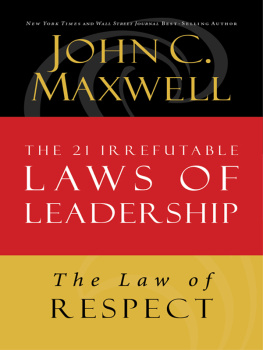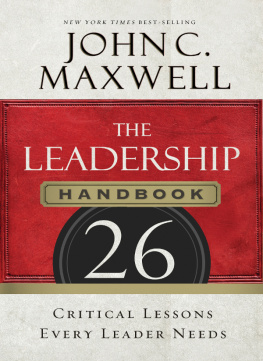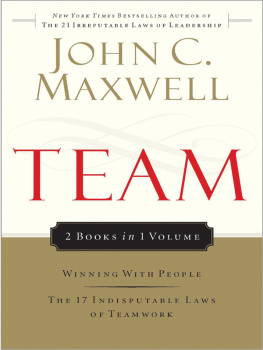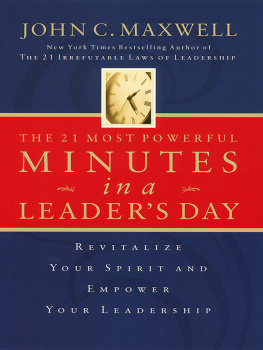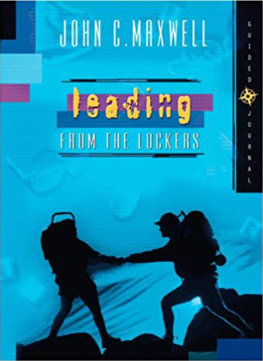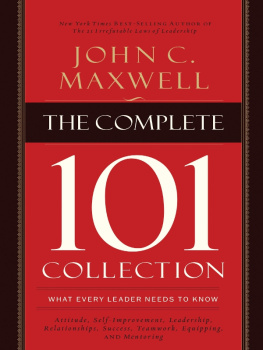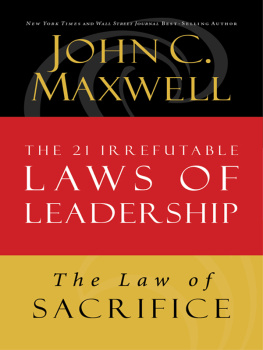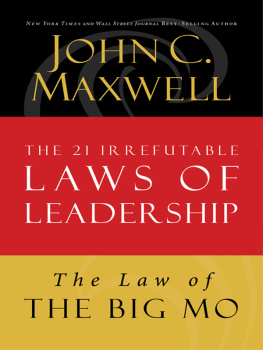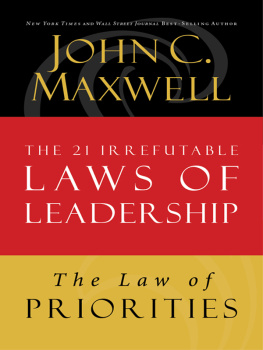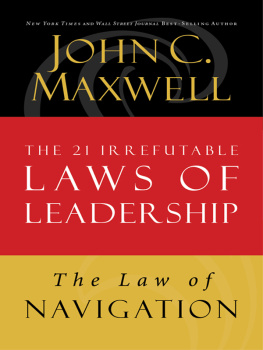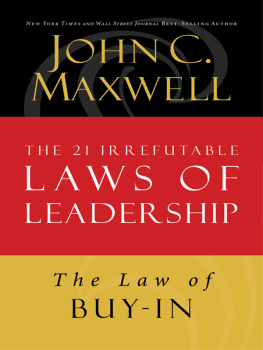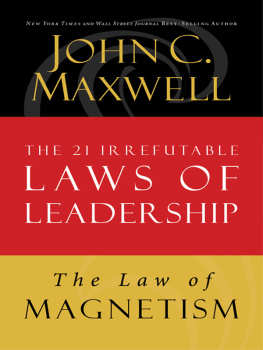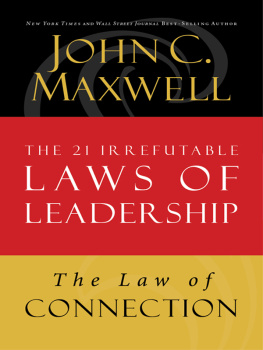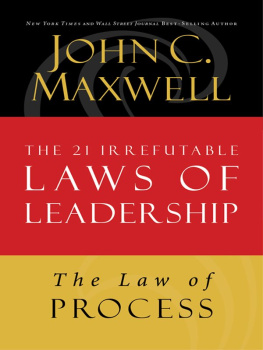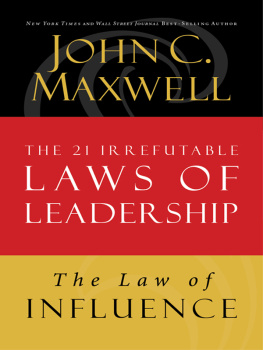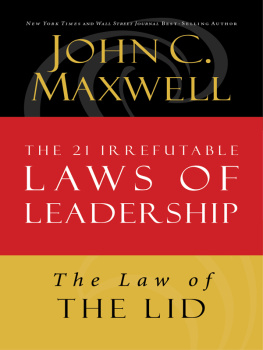
1998 and 2007 by John C. Maxwell
This ebook is derived from The 21 Irrefutable Laws of Leadership, by John Maxwell, 1998 and 2007 by Maxwell Motivation, Inc., a Georgia corporation.
All rights reserved. No portion of this book may be reproduced, stored in a retrieval system, or transmitted in any form or by any meanselectronic, mechanical, photocopy, recording, scanning, or otherexcept for brief quotations in critical reviews or articles, without the prior written permission of the publisher.
Published in Nashville, Tennessee, by Thomas Nelson. Thomas Nelson is a trademark of Thomas Nelson, Inc.
Thomas Nelson, Inc. titles may be purchased in bulk for educational, business, fund-raising, or sales promotional use. For information, please e-mail SpecialMarkets@ThomasNelson.com.
Published in association with Yates & Yates, LLP, Attorneys and Counselors, Orange, California.
Scripture quotations noted CEV are from THE CONTEMPORARY ENGLISH VERSION.
1991 by the American Bible Society. Used by permission.
Scripture quotations noted The Message are from The Message: The New Testament in Contemporary English. 1993 by Eugene H. Peterson.
ISBN 978-0-7852-7431-5 (HC)
ISBN 978-1-4185-3831-6 (ebook)
ISBN 978-1-4002-7566-3 (ebook of Chapter 7)

This book is dedicated to Charlie Wetzel, my writing partner since 1994. Together weve written more than forty books, and Ive enjoyed our collaboration on every one. As I have labored to add value to others by identifying and teaching leadership principles, Charlie, you have added value to me and my efforts. Your insights and skills as a wordsmith have been enjoyed by millions of readers. As a result, you have made a greater impact on more people than has anyone else in my inner circle. For that I thank you.
CONTENTS


Thank you to the thousands of leaders around the world who learned and sometimes challenged the laws of leadership, thus sharpening my thinking.
Thank you to the team at Thomas Nelson who gave me the chance to revise and improve this book, and especially to Tami Heim for her strategic leadership and to Victor Oliver who was instrumental in the development of the original concept.
Thank you to Linda Eggers, my executive assistant, and her assistant, Sue Caldwell, for their incredible service and willingness to go the extra mile every day.
Thank you to Charlie Wetzel, my writer, and Stephanie, his wife, with-out whose work this book would not have been possible.

People Naturally Follow Leaders Stronger Than Themselves
If you had seen her, your first reaction might not have been respect. She wasnt a very impressive-looking womanjust a little over five feet tall, in her late thirties, with dark brown weathered skin. She couldnt read or write. The clothes she wore were coarse and worn. When she smiled, she revealed that her top two front teeth were missing.
She lived alone. The story was that she had abandoned her husband when she was twenty-nine. She gave him no warning. One day he woke up, and she was gone. She talked to him only once after that, years later, and she never mentioned his name again afterward.
Her employment was erratic. Most of the time she took domestic jobs in small hotels: scrubbing floors, making up rooms, and cooking. But just about every spring and fall she would disappear from her place of employment, come back broke, and work again to scrape together what little money she could. When she was present on the job, she worked hard and seemed physically tough, but she also was known to suddenly fall asleepsometimes in the middle of a conversation. She attributed her affliction to a blow to the head she had taken during a teenage fight.
Who would respect a woman like that? The answer is the more than three hundred slaves who followed her to freedom out of the Souththey recognized and respected her leadership. So did just about every abolitionist in New England. The year was 1857. The womans name was Harriet Tubman.
A LEADER BY ANY OTHER NAME
While she was only in her thirties, Harriet Tubman came to be called Moses because of her ability to go into the land of captivity and bring so many of her people out of slaverys bondage. Tubman started life as a slave. She was born in 1820 and grew up in the farmland of Maryland. When she was thirteen, she received the blow to her head that troubled her all her life. She was in a store, and a white overseer demanded her assistance so that he could beat an escaping slave. When she refused and blocked the overseers way, the man threw a two-pound weight that hit Tubman in the head. She nearly died, and her recovery took months.
At age twenty-four, she married John Tubman, a free black man. But when she talked to him about escaping to freedom in the North, he wouldnt hear of it. He said that if she tried to leave, hed turn her in. When she resolved to take her chances and go north in 1849, she did so alone, without a word to him. Her first biographer, Sarah Bradford, said that Tubman told her: I had reasoned this out in my mind: there was one of two things I had a right to, liberty or death. If I could not have one, I would have the other, for no man should take me alive. I should fight for my liberty as my strength lasted, and when the time came for me to go, the Lord would let them take me.
Tubman made her way to Philadelphia, Pennsylvania, via the Underground Railroad, a secret network of free blacks, white abolitionists, and Quakers who helped escaping slaves on the run. Though free herself, she vowed to return to Maryland and bring her family out. In 1850, she made her first return trip as an Underground Railroad conductorsomeone who retrieved and guided out slaves with the assistance of sympathizers along the way.
A LEADER OF STEEL
Each summer and winter, Tubman worked as a domestic, scraping together the funds she needed to make return trips to the South. And every spring and fall, she risked her life by going south and returning with more people. She was fearless, and her leadership was unshakable. Hers was extremely dangerous work, and when people in her charge wavered or had second thoughts, she was strong as steel. Tubman knew escaped slaves who returned would be beaten and tortured until they gave information about those who had helped them. So she never allowed any people she was guiding to give up. Dead folks tell no tales, she would tell a fainthearted slave as she put a loaded pistol to his head. You go on or die!
Between 1850 and 1860, Harriet Tubman guided out more than three hundred people, including many of her family members. She made nineteen trips in all and was very proud of the fact that she never once lost a single person under her care. I never ran my train off the track, she said, and I never lost a passenger. At the time, Southern whites put a $12,000 price on her heada fortune. By the start of the Civil War, she had brought more people out of slavery than any other American in historyblack or white, male or female.
Next page
